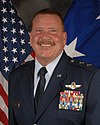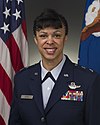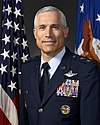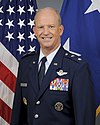United States Air Force numbered unit
Military unit
Twenty-Second Air Force (22 AF) is a Numbered Air Force component of Air Force Reserve Command (AFRC). It was activated on 1 July 1993 and is headquartered at Dobbins Air Reserve Base, Georgia.
In the event of mobilization, some of the Twenty-Second Air Force's subordinate units would come under the operational control (OPCON) of the Air Mobility Command's (AMC) 21st Expeditionary Mobility Task Force, headquartered at McGuire Air Force Base, New Jersey, while others would come under OPCON of Air Education and Training Command's 19th Air Force at Randolph AFB, Texas.[needs update]
Mission
22 AF is responsible for recruiting and training reservists and for maintaining subordinate units at the highest level of combat readiness. A by-product of training is to coordinate daily support of the active duty air force.
22 AF's wartime mission is to provide combat-ready airlift and support units and augments personnel requirements to Air Mobility Command in the United States.
Twenty-Second Air Force manages more than 25,000 Reservists and has 149 unit-equipped aircraft. Reserve crews in 22 AF fly the C-130 Hercules, including the WC-130 "Hurricane Hunter" aircraft, which are located at nine different Air Force Reserve wings. The wings, flying squadrons and support units are spread throughout nine states – from New York to Mississippi, Ohio and Minnesota, with its westernmost wing in Colorado Springs, Colorado.
History
Established as the Domestic Division, Air Corps Ferrying Command in the early days of World War II, the organization's mission was the transport of newly produced aircraft from points within the United States to Ports of Embarkation for shipment to Britain and other overseas Allies. In 1946, the organization was transferred to Air Transport Command and became, in essence, a military airline its Continental Division, managing transport routes within the United States.
When the USAF was created as a separate service in 1947, Military Air Transport Service was established to support the new Department of Defense, with responsibility for its support falling to the Department of the Air Force. Redesignated Western Transport Air Force (WESTAF), the organization managed all MATS operations from the Mississippi River west to the east coast of Africa until MATS was replaced by the Military Airlift Command in 1966. When MATS became MAC, WESTAF was redesignated 22d AF, with headquarters at Travis AFB, CA.
During the 1960s, Twenty-Second Air Force transports flew missions worldwide, supporting the efforts of the United States in Southeast Asia, Europe and other places around the world. In December 1974, the Twenty-Second Air Force absorbed Tactical Air Command's Twelfth Air Force C-130 Hercules tactical airlift operations.
On 29 March 1979, the Twenty-Second Air Force assumed responsibility for managing Military Airlift Command resources in the Pacific. For this mission, the unit provided a single commander for MAC airlift units in the Pacific theater; command and control of theater-assigned airlift forces for Pacific Air Forces; theater tactical airlift war planning and Pacific exercise planning; and aerial ports in the Pacific area to support the air movement of personnel, cargo, equipment, patients, and mail. The division participated in tactical exercises such as Team Spirit, Ulchi Focus Lens, and Capstan Dragon.
The unit was relieved from assignment to Military Airlift Command and assigned to Air Mobility Command on 1 June 1992. Activated the same day at Dobbins ARB, GA, with a change in assignment to the Air Force Reserve. It is under the peacetime command of Headquarters Air Force Reserve Command at Robins Air Force Base, GA.





















